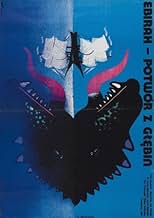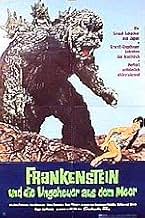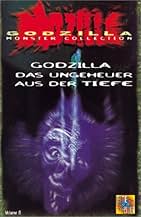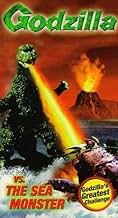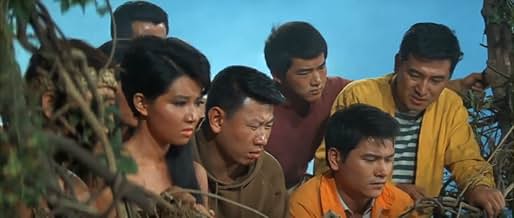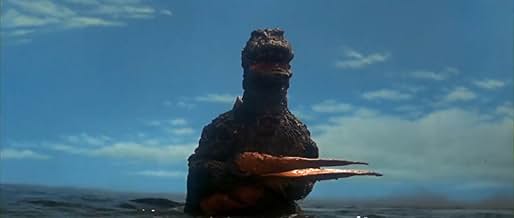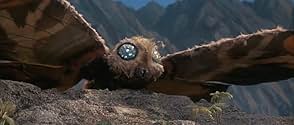Godzilla contra el terror de los mares
Título original: Gojira · Ebira · Mosura Nankai no daikettô
CALIFICACIÓN DE IMDb
5.5/10
6.9 k
TU CALIFICACIÓN
Agrega una trama en tu idiomaFour men searching for one's brother are shipwrecked on Letchi Island, where they encounter Godzilla, a monstrous lobster, and terrorists who have enslaved the natives of Infant Island.Four men searching for one's brother are shipwrecked on Letchi Island, where they encounter Godzilla, a monstrous lobster, and terrorists who have enslaved the natives of Infant Island.Four men searching for one's brother are shipwrecked on Letchi Island, where they encounter Godzilla, a monstrous lobster, and terrorists who have enslaved the natives of Infant Island.
- Dirección
- Guionista
- Elenco
- Dirección
- Guionista
- Todo el elenco y el equipo
- Producción, taquilla y más en IMDbPro
Opiniones destacadas
This is the second Godzilla movie to this point that wasn't directed by Ishiro Honda (first being Godzilla Raids Again), and was directed by Jun Fukuda. Fukuda chose Masaru Sato to compose the music instead of Akira Ifukube, and overall contributes to the lighter touch. Shinichi Sekizawa's screenplay continues on the trend of humanizing the monsters, and Ebira's pose before the battle is a caricature of the then popular professional wrestler Toyonobori, and Godzilla rubbing his index finger on his nose is a caricature of Yuzo Kayama's character in Wakadaisho series which usually played at same time as the Godzilla movies as a double feature. The cinematography is noticeably brighter and the characters are also bit more easy going than Honda's version of Godzilla movies.
Ryota (Tetsu Watanabe) who lost his brother in the South Pacific in a fishing boat accident believes in the prediction made by a spiritual medium in Mt. Osore that his brother is still alive. He comes out to Tokyo to look for a way to get to his brother. There he meets few college students and later a thief named Yoshimura (Akira Takarada) in a sailboat they've snuck into. While everyone's asleep, Ryota sets sail to the south pacific to search for his brother. In a stormy sea the sailboat runs aground on an island occupied by a gang who calls themselves the "Red Bamboo". Red Bamboo is kidnapping the residents of Infant Island (Mothra Island) as slave labor to further their cause. Dayo (Kumi Mizuno) a girl from Infant Island escapes into the jungle and meets Ryota and Yoshimura's crew. There they hide in a cave to escape Red Bamboo's pursuit. Unbeknownst to them, that cave contained a hibernating Godzilla. Yoshimura comes up with a novel plan to wake Godzilla and turn it against the Red Bamboo.
In this movie, the fairies that talks to Mothra also changed from The Peanuts (Emi and Yumi Ito) to another twins Pair Bambi (Yuko and Yoko Okada - born 4/19/1944 Nagoya Japan). They were already 15 year veteran in the show business when they stared in this movie. Originally, Noriko Takahashi was to play the part of Dayo, but fell ill to appendicitis so was changed to Kumi Mizuno at the last minute. Mizuno who was 29 at the time played the role written for a 19 year old girl. Takahashi 6 month earlier played a similar role in Tsuburaya Production's Ultra Q series as a native girl who lost her brother to a giant octopus.
In the mid to late sixties, Godzilla movie started to slide to a lighter stories. This movie took the formula one step further from the previous Godzilla move the "Monster Zero", and continues the humanization of Godzilla and the monsters. Jun Fukuda's directing isn't up to par with Honda's and the props look cheezy by comparison which took away from the story, but most likely the movie was intended for kids and this was part of their production plan. The good in this movie was Akira Takarada and Kumi Mizuno that brought character to acting. Overall the movie succeeded because these two characters kept the focus. Good entertainment from the '60s Toho studio.
Ryota (Tetsu Watanabe) who lost his brother in the South Pacific in a fishing boat accident believes in the prediction made by a spiritual medium in Mt. Osore that his brother is still alive. He comes out to Tokyo to look for a way to get to his brother. There he meets few college students and later a thief named Yoshimura (Akira Takarada) in a sailboat they've snuck into. While everyone's asleep, Ryota sets sail to the south pacific to search for his brother. In a stormy sea the sailboat runs aground on an island occupied by a gang who calls themselves the "Red Bamboo". Red Bamboo is kidnapping the residents of Infant Island (Mothra Island) as slave labor to further their cause. Dayo (Kumi Mizuno) a girl from Infant Island escapes into the jungle and meets Ryota and Yoshimura's crew. There they hide in a cave to escape Red Bamboo's pursuit. Unbeknownst to them, that cave contained a hibernating Godzilla. Yoshimura comes up with a novel plan to wake Godzilla and turn it against the Red Bamboo.
In this movie, the fairies that talks to Mothra also changed from The Peanuts (Emi and Yumi Ito) to another twins Pair Bambi (Yuko and Yoko Okada - born 4/19/1944 Nagoya Japan). They were already 15 year veteran in the show business when they stared in this movie. Originally, Noriko Takahashi was to play the part of Dayo, but fell ill to appendicitis so was changed to Kumi Mizuno at the last minute. Mizuno who was 29 at the time played the role written for a 19 year old girl. Takahashi 6 month earlier played a similar role in Tsuburaya Production's Ultra Q series as a native girl who lost her brother to a giant octopus.
In the mid to late sixties, Godzilla movie started to slide to a lighter stories. This movie took the formula one step further from the previous Godzilla move the "Monster Zero", and continues the humanization of Godzilla and the monsters. Jun Fukuda's directing isn't up to par with Honda's and the props look cheezy by comparison which took away from the story, but most likely the movie was intended for kids and this was part of their production plan. The good in this movie was Akira Takarada and Kumi Mizuno that brought character to acting. Overall the movie succeeded because these two characters kept the focus. Good entertainment from the '60s Toho studio.
This was obviously made because Toho wanted to discover new plot elements for their kaiju film formula, which was falling into something of a predictable rut (humans fight humans, humans fight monster, monster fights monster, sayonara). But simply limiting the amount of time the monsters appear on screen offers no improvement.
"Sea Monster" is one of the weaker entries in the original Godzilla series. Much of the film is directed as light comedy, a mild satire on the James Bond films. Actually, the comedy works pretty well; it's never knee-slapping laugh-out-loud, but it finds and sustains a level of humor most viewers should find fairly easy to live with.
The monsters here are almost tossed in for deus-ex-machina plot devices, saving the day at the last moment. To be sure, it's amusing to see Godzilla sit around pondering what to do with the woman he's just saved from bad guys, but there really isn't much for him to do here. He zaps a giant vulture, pulls the claws off a lobster and smashes a nuclear power plant - and that's about it. For a minute towards the end, it almost looks like things will get complicated by a battle between Godzilla and Mothra, but this doesn't really amount to much either.
For Godzilla completists, it's a relatively harmless sub-par entry - it certainly doesn't scrape the same bottoms as "Godzilla's Revenge" or "vs. Megalon". But if you are not yet a Big G. fan, this should not be your introduction to the series.
Entertaining fluff, nothing more.
"Sea Monster" is one of the weaker entries in the original Godzilla series. Much of the film is directed as light comedy, a mild satire on the James Bond films. Actually, the comedy works pretty well; it's never knee-slapping laugh-out-loud, but it finds and sustains a level of humor most viewers should find fairly easy to live with.
The monsters here are almost tossed in for deus-ex-machina plot devices, saving the day at the last moment. To be sure, it's amusing to see Godzilla sit around pondering what to do with the woman he's just saved from bad guys, but there really isn't much for him to do here. He zaps a giant vulture, pulls the claws off a lobster and smashes a nuclear power plant - and that's about it. For a minute towards the end, it almost looks like things will get complicated by a battle between Godzilla and Mothra, but this doesn't really amount to much either.
For Godzilla completists, it's a relatively harmless sub-par entry - it certainly doesn't scrape the same bottoms as "Godzilla's Revenge" or "vs. Megalon". But if you are not yet a Big G. fan, this should not be your introduction to the series.
Entertaining fluff, nothing more.
This is actualy a fun film if you're a kid, and i loved godzilla when i was i think back to the days of watching those chessy B movies(i havnt realy progresed that far in 10 years) and this was one of my favriotes and now somthing that angers me is it having a 4 point rating i mean kids love this and its fun and next time you get a chance pop one of these in have a good laugh and look back at you're childhood you'll have more fun then you would think.Now that thats gone ill fill you with my memories of this film the specel effects are alright and about what you would expect. Plot? we dont need no stinking plot!!! so botom line if you're a kid you'll love it and if you're with friends and older and in serch of a laugh you'll love it for its chessyness.
This is one of the first Godzilla movies I saw, and when I see it now after seeing almost all of the other movies, it still holds up pretty well. The main problem is, of course, Ebirah. Definetly Godzilla's worst foe. I mean, really, A GIANT LOBSTER!? But, other than that, the film is quite good, following the usual trend that the Godzilla movies tend to have much better plots than their american counterparts of the time. Here we have a young man trying to find his brother taking his friends with him to look at boats. When they board one to look around, they find a man with a gun to greet them. He claims to be the owner and allows them to spend the night on the boat. When they wake up the next morning, however, the young man has taken the boat to find his brother. It's wrecked in a storm and they are stranded on an island where they discover a secret organisation called the Red Bamboo is using slave labor to make nuclear weapons. Ebirah, a giant lobster, prevents boats from entering or leaving the island, and Okondoru, a giant condor, prevents planes from arriving. The man who claimed to own the boat, Yoshimura, turns out to be both a thief and the most resourceful member of their little group (which now also includes an escaped slave played by the wonderful Kumi Mizuno). They discover that Godzilla is sleeping on the island, so they wake him up in order to stop the Red Bamboo. He trashes the base, defeats the two other, ahem, monsters, and the slaves and group are all saved by Mothra (who really isn't looking to good by now). The thief, Yoshimura, is definetly my favorite character in this, and the special effects are pretty good at times (he may be a pathetic monster, but Ebirah looks great). As a bonus, it also makes for a great MST3K episode.
Of all the Japanese monster films that came out from the mid Fifties to the mid Seventies, Godzilla Versus The Sea Monster is the only one that seems to have taken a political stand on anything. The Japanese for obvious reasons are big on nuclear disarmament. This film involves Godzilla and two other giant monsters involved with the Red Bamboo who are a group conducting nuclear experiments on a deserted south sea island. Of course there was no such a group as the Red Bamboo, but the power across the Sea of Japan did have a Red Guard who were pretty active in those days. I think that was another political statement that Godzilla Versus The Sea Monster was making.
Anyway some 20 somethings who were involved in a dance marathon which opened the film, commandeer a boat that was to be the getaway vehicle of a bank robber to search for the brother of one of them who set sail southeast and was not heard from.
It's there that a storm washes them ashore on the island of the Red Bamboo. These dastardly folks are not only conducting nuclear experiments, they're making heavy water to use as nuclear fuel, but are using slave labor. The slaves are being taken from the island that Mothra resides, but he's sleeping and the natives are doing their best to arouse their friend and protector.
To discourage escape in the meantime, the island is guarded by Ebirah a giant lobster monster. The Red Bamboo controls him by means of the nectar of some exotic tropical fruit that acts as a tranquilizer.
When our heroes arrive, they discover that Godzilla is in some kind of coma asleep on the island. Needing an ally they look to get him awake to start doing his thing. Of course all three monsters battle it out in the end.
This particular all star monster spectacular is a cut above the others for its political statement wrapped up in the dopey way these films play. But I have to admit a soft spot in my heart for them.
Anyway some 20 somethings who were involved in a dance marathon which opened the film, commandeer a boat that was to be the getaway vehicle of a bank robber to search for the brother of one of them who set sail southeast and was not heard from.
It's there that a storm washes them ashore on the island of the Red Bamboo. These dastardly folks are not only conducting nuclear experiments, they're making heavy water to use as nuclear fuel, but are using slave labor. The slaves are being taken from the island that Mothra resides, but he's sleeping and the natives are doing their best to arouse their friend and protector.
To discourage escape in the meantime, the island is guarded by Ebirah a giant lobster monster. The Red Bamboo controls him by means of the nectar of some exotic tropical fruit that acts as a tranquilizer.
When our heroes arrive, they discover that Godzilla is in some kind of coma asleep on the island. Needing an ally they look to get him awake to start doing his thing. Of course all three monsters battle it out in the end.
This particular all star monster spectacular is a cut above the others for its political statement wrapped up in the dopey way these films play. But I have to admit a soft spot in my heart for them.
¿Sabías que…?
- TriviaThis film was originally written to star King Kong, as Rankin/Bass Productions had provided Toho with the license to the character in order to produce a tie-in film for Toei's animated TV series King Kong (1966), which they co-produced. However, Rankin/Bass rejected the original treatment, as they wanted director Ishirô Honda to helm the film. Toho insisted on Jun Fukuda and after Rankin/Bass backed out, Toho decided to replace King Kong with Godzilla. Toho and Rankin/Bass would then go on to co-produce El regreso de King Kong (1967), a film that was more in line with what Rankin/Bass wanted.
- ErroresAt the end of the film, as Mothra flies back to Infant Island, the large net she is carrying with her feet with the humans inside it is missing.
- Créditos curiososFor the Columbia/Tri-Star U.S. DVD release of the film, which uses the original uncut Japanese version of it, its English-language credits list the noted composer Masaru Satô as "Mararu Sato."
- Versiones alternativasThe Mystery Science Theater 3000 version of the film featured a Film Ventures-lensed print of it that used a different title sequence made up of clips from the next film in the Godzilla series, El hijo de Godzilla (1967).
- ConexionesEdited into Gojira Minira Gabara Ôru kaijû daishingeki (1969)
Selecciones populares
Inicia sesión para calificar y agrega a la lista de videos para obtener recomendaciones personalizadas
- How long is Ebirah, Horror of the Deep?Con tecnología de Alexa
Detalles
- Fecha de lanzamiento
- País de origen
- Idioma
- También se conoce como
- Ebirah, Horror of the Deep
- Productora
- Ver más créditos de la compañía en IMDbPro
Taquilla
- Presupuesto
- USD 1,200,000 (estimado)
- Tiempo de ejecución1 hora 27 minutos
- Mezcla de sonido
- Relación de aspecto
- 2.35 : 1
Contribuir a esta página
Sugiere una edición o agrega el contenido que falta

Principales brechas de datos
By what name was Godzilla contra el terror de los mares (1966) officially released in India in English?
Responda

